Capacitance of a parallel plate air capacitor depends on
Thickness of conducting plates
Charge on the conducting plates
Important Questions on Electrostatics

is the permittivity of free space]
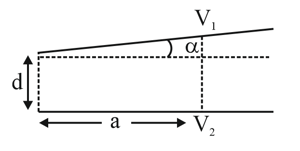
Two identical parallel plate capacitors of capacitance each are connected in series with a battery of emf, as shown. If one of the capacitors is now filled with a dielectric of dielectric constant , the amount of charge which will flow through the battery is (neglect internal resistance of the battery)
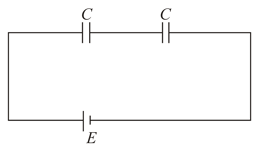
A parallel plate capacitor has uniform electric field in the space between the plates.If the distance between the plates is and area of each plate is , the energy stored in the capacitor is ;
A parallel plate capacitor is made of two circular plates separated by a distance of 5 mm and with a dielectric of dielectric constant 2.2 between them. When the electric field in the dielectric is , the charge density of the positive plate will be close to :
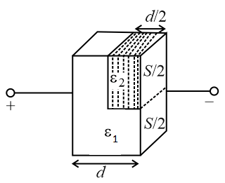
A parallel plate capacitor having cross-sectional area and separation has air in between the plates. Now an insulating slab of the same area but the thickness, , is inserted between the plates as shown in figure having dielectric constant The ratio of new capacitance to its original capacitance will be,
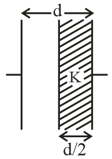
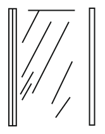
A parallel plate capacitor has plates of area A separated by distance between them. It is filled with a dielectric which has a dielectric constant that varies as where is the distance measured from one of the plates. If the total capacitance of the system is best given by the expression:
A parallel plate capacitor of two plates, each with area , is separated by air-gap. The capacitor is initially connected to source. When an unknown liquid is filled between the plates so as to fill the air-gap, an additional charge of is found to be flowing onto the capacitor from the source. The dielectric constant of the liquid is
(Assume )
A parallel plate capacitor has a dielectric slab of dielectric constant K between its plates that covers 1/3 of the area of its plates, as shown in the figure. The total capacitance of the capacitor is C while that of the portion with dielectric in between is . When the capacitor is charged, the plate area covered by the dielectric gets charge and the rest of the area gets charge . The electric field in the dielectric is and that in the other portion is . Choose the correct option/options, ignoring edge effects.
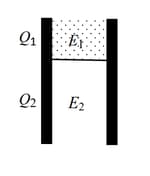

In the figure is shown a system of four capacitors connected across a battery. The charge that will flow from switch S when it is closed is:


